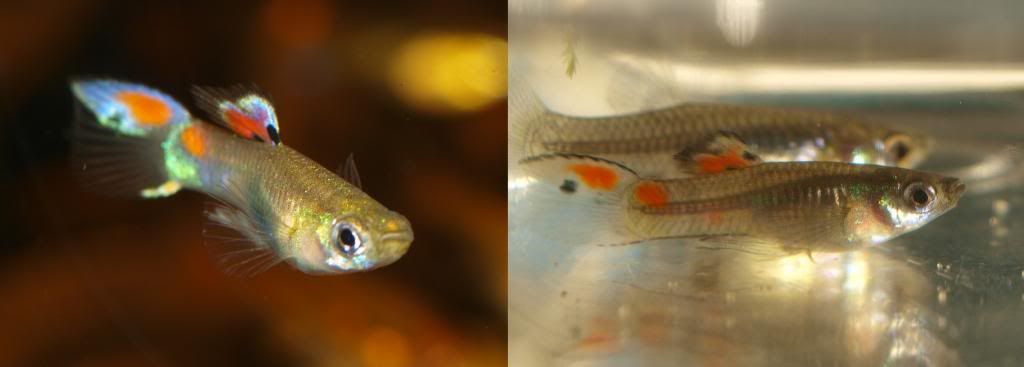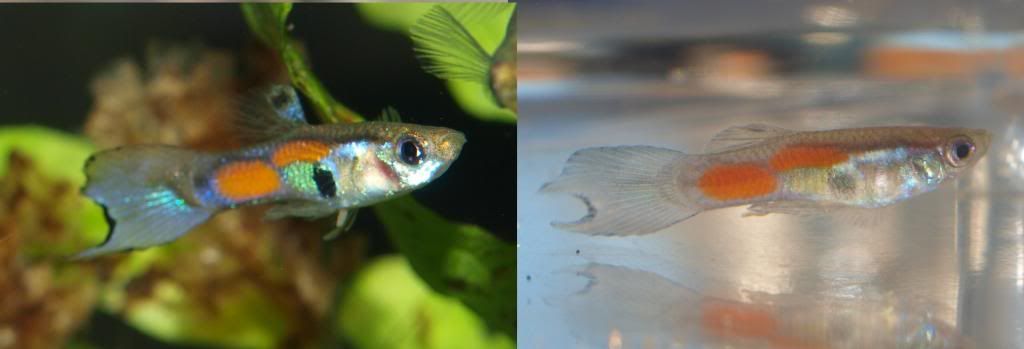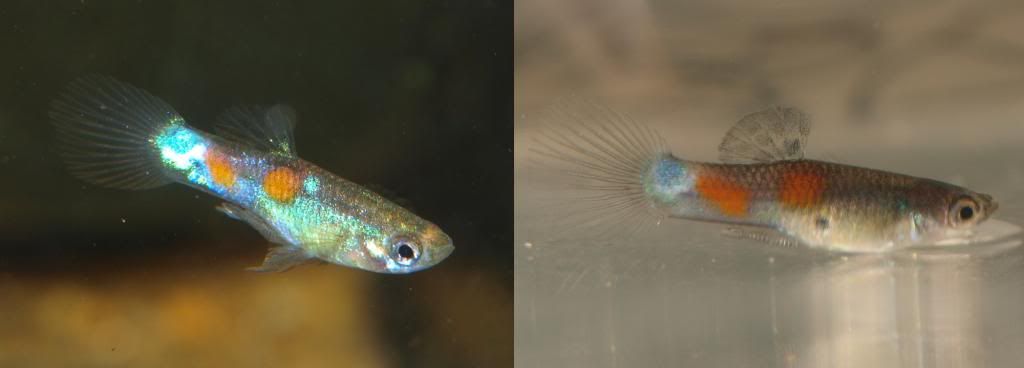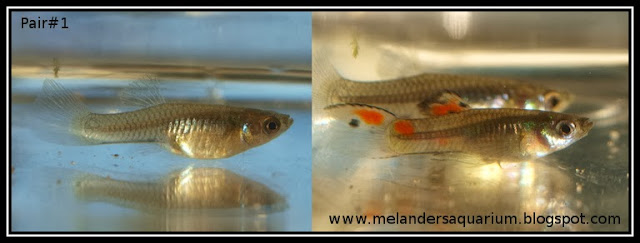Here is a quick update of my fathers tank, 30+ years running (more about this tank under Archived Posts).
The bottom photo is from last Christmas 2012 and the upper photo is from today, 2013.
As you can see black beard algae has taken over the tank during the year. I do like it for some reason, but it will have to go.
Friday, 20 December 2013
Wednesday, 11 December 2013
Updated photos, Wild Brazilian Guppies, Poecilia reticulata
The new wild caught
Brazilian guppies have now been separated into individual tanks to make sure
that all of the founders get a chance to reproduce.
The photos on the left were taken when the males had settled down a bit, they are quite different then the stress colouration shown on the right.
Even now I do not find that the photographs are particularly representative as these fish seems to display different colours depending on moods, setting and lighting.




All of the females have dropped fry which is great, and the fish seem to have settled in well.
More to come regarding these,
The photos on the left were taken when the males had settled down a bit, they are quite different then the stress colouration shown on the right.
Even now I do not find that the photographs are particularly representative as these fish seems to display different colours depending on moods, setting and lighting.




All of the females have dropped fry which is great, and the fish seem to have settled in well.
More to come regarding these,
Labels:
brazil,
brazilian,
breeding,
caught,
founders,
guppies,
guppy,
ireland,
male,
photo,
photos,
pictures,
poecilia,
reticulata,
south america,
wild,
wild caught
Thursday, 5 December 2013
Corydoras concolor, Male
Got a lucky snap last night of the alpha male feeding from the surface.
This individual has been the strongest and fastest grower since they were about 3cm in length, he is now the boss of the tank and a stunning fish imo.
Andreas
Sunday, 1 December 2013
Oak Leaves
 |
| Todays crop: a box of dryed oak leaves |
Dead leaves are beneficial to the home aquaria in many ways. I'm using oak leaves myself and as this is the season to be picking them I thought I would write a quick post about them.
Why Leaves
The benefit of using leaves in the aquaria are many and there is plenty information available on this subject, I will shorty highlight some of them below.Looks
Many of our aquarium fishes come from habitats littered with leaves. Heiko Bleher himself mentioned how he knew that he would find Apistogramma species in a leaf litter habitat (MaxiZoo talk, Dublin 2013). Oak leaves are a great way for any aquarist that wants to try to replicate such a habitat and it does usually look great.
Biotope/breeding
Tannins released from the leaves helps lowering the pH and stain the water to a tea-color. This further replicates the habitats of many blackwater species. Replicating the natural habitat in this way will significantly increase any breeding attempts.
Hiding
Leaf litter provides an abundance
of hiding spots for fry and adult fish alike which adds to the general wellbeing
of the fish. In a breeding tank leaves can be the difference between a good
survival rate of fry or an unsuccessful attempt.
Food source
The leaves are also
beneficial to the growth of fry as they provide an environment for
microorganisms on which many fry feed. I often use oak leaves in my rearing tanks and
lately a batch of Hypancistrus debilittera were grazing eagerly on the leaves,
the batch grew very well and I contribute part of that to the constant availability
of food, deriving from the leaves.Preparation
I have only used oak leaves and can only comment on them.Collection
Pick clearly dead/dry leaves of a species you know is aquarium safe. Pick only leaves that have already fallen to the ground. Avoid leaves from a polluted area, rotting, exhibit fungi growth or anything else you are not sure about.
Storage
Store the leaves in a dry area, I use an open card box for this purpose. Do not store them in plastic bags or sealed container until you are certain that they are completely dried out. Pick out any “bad” leaves prior to use. I usually dry the leaves for at least a month before use.
Use
Adding leavesAdd the leaves gradually, you will get familiar with how much leaves you need and how they affect the color of the water. The leaves will decompose over time, you can either leave them as they are or if you are afraid of leaf matter clogging the filter/spoiling the looks; siphon the smaller pieces out while performing a water change. Just make sure that you don’t siphon out your fry, in a set up with leaf litters fry can often go unnoticed from view.
Fish species
The effect the leaves have on the water makes them suitable for blackwater species. Personally I use oak leaves in tanks with species of Ancistrus, Corydoras, Hara, Peckoltia, Pelvicachromis and various tetras. Make however sure of what conditions the particular species you keep needs before planning the tank.
Labels:
aquarium,
biotope,
breeding,
fish,
leaf,
leaves,
litter,
natural,
oak,
preparation,
south america,
spawning,
tank
Tuesday, 26 November 2013
Wild Brazilian Guppies, Poecilia reticulata
I have gotten my hands on
some wild caught Brazilian Guppies, these are great little fish and I'm really looking
forward to keeping them. The fish has gotten me interested in guppies and I
have even joined the forum www.guppy.se where I have gotten some great advice.
The original "founders" consist of four males and four females picked out from an import of around 500 animals. The eight spent about a month in a quarantine tank where approximately 20 little fry were released.
My intent is to maintain this strain long-term, for this reason the four pairs have been separated to make sure that each individual gets a chance to reproduce. The fry from the quarantine tank are also being kept in a separate tank as it is likely that they are the offspring from males in the shop and therefor add to the genetic diversity of the total group.
These are the four pairs; note that the photographs show the fish in stress coloration. They are all far more colourfull in real life.
The plan is to follow and record their progress, the next step is to try to take some photographs of the males in their new tanks when they have settled in and colored up.
Offspring from the originals groups, 2015.02.01:
The original "founders" consist of four males and four females picked out from an import of around 500 animals. The eight spent about a month in a quarantine tank where approximately 20 little fry were released.
My intent is to maintain this strain long-term, for this reason the four pairs have been separated to make sure that each individual gets a chance to reproduce. The fry from the quarantine tank are also being kept in a separate tank as it is likely that they are the offspring from males in the shop and therefor add to the genetic diversity of the total group.
These are the four pairs; note that the photographs show the fish in stress coloration. They are all far more colourfull in real life.
The plan is to follow and record their progress, the next step is to try to take some photographs of the males in their new tanks when they have settled in and colored up.
Offspring from the originals groups, 2015.02.01:
Wednesday, 13 November 2013
L046, Hypancistrus zebra t-shirt design
The Hypancistrus zebra, L046 design is now finished and t-shirts sporting this motif are available @: www.happypleco.com. This stunning species is now along with many other species under threat from the construction of the Bela Monte Dam, Rio Xingu, Brazil.
Thursday, 7 November 2013
Notes on breeding Hypancistrus debilittera, L129
There are three positive sides which made me decide on this species; it’s small, beautiful and relatively affordable compared to many other L-numbers. Its small size makes it easy to keep a decent sized group. The males have showed very little aggression so far which also helps.
The group was bought from Seahorse Aquariums in the beginning of June 2013 and consists of two males and three females. The individuals were wild caught young adults in good condition which made it easy to sex them by viewing them from above. The males had a distinct V-shape and showed “hairy” odontodal growth along the lower body, the females were quite plump in comparison. I have been wrong many times when sexing plecos but these were quite easy (or I got lucky).
The group reside in my 125 litre corner tank along with 12 Ember Tetras and some Otocinclus cocama.
The tank is filtered by a small air driven sponge filter as well as a 600 L/H powerhead with a large sponge, the powerhead creates a moderate currents which flows along the front glass of the tank.
Readings:
Temp 26°C
pH 6-6.5
German hardness °dH 3
Wood and roots comprise the furniture as well as six small sized (often used for L046) breeding caves plus a few coconuts.
The dominant male chose a cave near the front of the tank with the entrance exposed to the current. Strangely the second male never settled in one particular cave. The females seem to prefer roots and coconut shells as temporary hiding spots.
Four spawns have taken place so far with a few weeks in between each. It looks like the females take turns to mate with the dominant male. The male has only guarded one clutch at a time compared to for instance common Ancistrus where the male can guard clutches from several females at the same time.
This is the point where I started to have problems. The tank is not a dedicated breeding tank hidden away from disturbance, its placed in the living room. Any disturbance such as a water change or a lot of movement in the room has triggered the male to eat the larva and fortunately in the process “fanning out” some of them that could be rescued.
The last time I witnessed the event it was extremely frustrating watching dead larva with their yolk sacks eaten being flushed out from the cave. The cluthes seems quite small, I'm not sure exactly but it seems that the egg count have been around 10-15 max, maybe less.
Both Darren and Bart from www.irishfishkeepers.com have advised to cover the tank and this would probably work. I would however prefer to find another solution as the tank was supposed to be a “display tank”. Before going down this route I will cover up the males cave with roots and hope that this will make him feel a bit more secure and obscure his line of sight from movement in the room. The male is also young (possibly first spawns) and he might get more comfortable in time.
Not all was lost though as I have managed to catch some of the newly hatched larva that were flushed out. These were raised without problems in the floating breeding trap above, they grew fast and at a length of about 2cm TL they were released back into the tank to fend for themselves. The breeding trap was cleaned once per day; the sides were gently brushed with a tooth brush and uneaten food was removed with a turkey baster. The fry were fed twice per day with a variation of dry foods. The box also contained oak leafs which the fry seemed to feed greedily from. Fresh water from the main tank was flushed into the box trough a small air-lift sponge filter. I let few snails reside in the breeder box as a clean up crew for any uneaten food that i might have missed.
I’ll update this post if there is any news on the nervous male, he is at the moment guarding a new batch so fingers crossed.
Update 1:
I just fished out these little lads from their parent’s tank. They are from one of my first spawns of Hypancistrus debilittera, L129 and I believe that I managed to catch roughly two thirds from that batch.
It is very important for the growth and well-being of young plecos that they are not kept in too crowded conditions. Even more so when several batches share the tank as the smaller ones will have a very tough time competing for food and hiding spots against their larger siblings.
These fish were moved so that their younger siblings can get a chance to grow properly and become strong little fishes.They have now moved to a 72 litre tank with strong filtration and plenty of hiding spots.
Update 2:
After the spawns described above the male calmed down and started to raise the fry himself, no further intervention was needed and the fish now spawn regularly once per month.
Wednesday, 30 October 2013
Friday, 25 October 2013
D.I.Y. simple fry rearing box
This is a very simple, cheap
but effective fry rearing box. This example does not have proper floating
supports as it's resting on a root in my tank. Floating support or something to
anchor the box to the side of an aquarium would be easy to ad.
What you need: plastic box with a lip at the top to hold some air, silicone, carpet knife, filter foam, and a spare small airlift filter:
A hole was cut at one end of the box and sealed with filter foam, attached with silicone. This will drain the box and keep the water level the same as in the tank it is in. The air driven filter will pump in fresh water from the tank into the box:
Side view:
From above:
This is a variation of a design that has been used by aquarists for many years.
The benefit of this type is that air driven filter constantly supplies the fry/eggs with fresh water from the same tank that they originally were laid in/hatched in. This method also keeps the water conditions stable which is extremely important with fragile fish, something that can be harder to achieve in a small
separate tank.
Another benefit is that the breeder box makes it easy to make sure that the fry eat, the small space makes it possible to target feed fry while fry in a larger tank might not even find the food in time.
Maintenance of the rearing box is still important though and uneaten food and bacteria on the sides should be removed/cleaned on a regular basis. A turkey baster works quite well for this purpose, and a tooth brush can be used to clean the sides.
Depending on species and strength of the air pump used it can also be a good idea to add an air stone for increased water circulation.
Personally I use this type for plecos and corys; I ad gravel/sand from the main tank, some small plants/moss/roots/oak leafs/ for the fry to hide in.
Remember that we want the fry to feel comfortable and not stressed as this increases their growth rate and lowers the risks of deaths.
What you need: plastic box with a lip at the top to hold some air, silicone, carpet knife, filter foam, and a spare small airlift filter:
A hole was cut at one end of the box and sealed with filter foam, attached with silicone. This will drain the box and keep the water level the same as in the tank it is in. The air driven filter will pump in fresh water from the tank into the box:
Side view:
From above:
This is a variation of a design that has been used by aquarists for many years.
The benefit of this type is that air driven filter constantly supplies the fry/eggs with fresh water from the same tank that they originally were laid in/hatched in. This method also keeps the water conditions stable which is extremely important with fragile fish, something that can be harder to achieve in a small
separate tank.
Another benefit is that the breeder box makes it easy to make sure that the fry eat, the small space makes it possible to target feed fry while fry in a larger tank might not even find the food in time.
Maintenance of the rearing box is still important though and uneaten food and bacteria on the sides should be removed/cleaned on a regular basis. A turkey baster works quite well for this purpose, and a tooth brush can be used to clean the sides.
Depending on species and strength of the air pump used it can also be a good idea to add an air stone for increased water circulation.
Personally I use this type for plecos and corys; I ad gravel/sand from the main tank, some small plants/moss/roots/oak leafs/ for the fry to hide in.
Remember that we want the fry to feel comfortable and not stressed as this increases their growth rate and lowers the risks of deaths.
Subscribe to:
Comments (Atom)




















